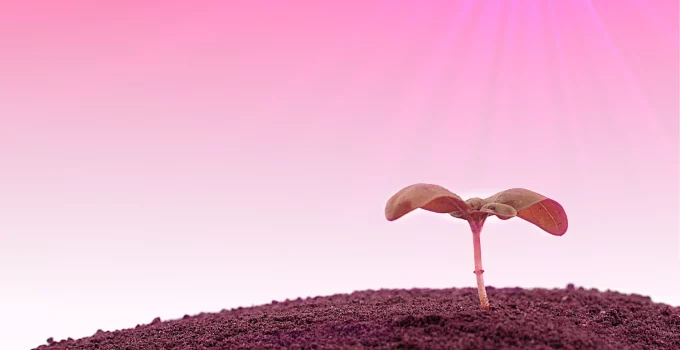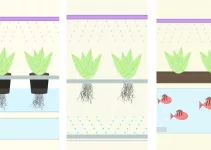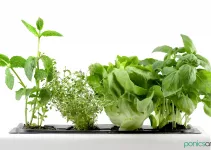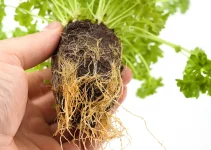I will begin my T5 vs LED grow lights comparison by quickly answering two important questions: which is better and which should you get. Later on I’ll get into more details about what makes the two different, what characterizes them and what defines these two types of grow lights for plants.
The major thing that these two have in common is that they’re both grow lights.
The major difference is that full-spectrum LED grow lights are certainly more popular and are generally considered the superior option when choosing grow lights for our plants, no matter what type of plants we’re growing.
Both T5 and LEDs can be used as grow lights for plants. If you’re growing indoors, whether you use containers, hydroponics kits, mason jar hydroponics or aquaponics kits, you’re going to need some type of grow light. T5s and LEDs are two of the most popular choices and I truly believe that, generally, you can’t go wrong with either.
Grow lights are definitely not as efficient as direct sunlight but growing indoors is usually equivalent to needing artificial grow lights for our plants.
On the other hand, if we’re growing in greenhouses, we can benefit from some form of sunlight but we’ll still need supplemental lighting. Supplemental lighting is an artificial light to build on what the sun can naturally provide.
We’re here debating T5 vs LED grow lights because these two are some of the best and the most popular for household growers. LEDs are overall the winner for a large majority of people.
Table of Contents
T5 vs LED Grow Lights: Which Is Better?
It might sound cliché but I consider that both can be really good, even if LED grow lights are the overall clear winner for a large base of growers. T5 and LED grow lights are awesome light options for growing plants, both for vegging and flowering stages.
To put it simply: white LED light emitted by full-spectrum LED grow lights is the best light for growing plants indoors.
T5 fluorescent lights work very well for growing smaller plants and are especially great for growing microgreens.
Moreover, T5 can also be an efficient way to grow all kinds of plants, from vegetables to flowers.
Another proof that T5 grow lights can be beneficial to a variety of plants is that they support taller plants up to 24 inches. If you’re growing smaller tomato varieties they can work even for those, especially if you also get some sunlight throughout the day. You can use them as supplemental lights.
You can place T5s 0-12 inches above the plants. People usually stick to 1-4 inches above the plants.
Why LED grow lights are better than T5
You might already consider that LED grow lights are a better choice than T5 lamps. And I would say that you’re absolutely right.
This study also established that plants grown under LEDs have an increased growth rate compared to those that are grown under T5 or T8 fluorescent light.
Full-spectrum LED grow lights produce the necessary wavelengths of light needed for successful plant growth through all stages.
Even though most of us prefer using LEDs for our plants that doesn’t mean that we should dismiss the option of using T5s. It definitely depends on our needs and budget but it’s always nice to know that we can choose either and still obtain a very nice indoor crop.
LEDs are certainly the more popular choice, which can make it possible to find quite affordable models, too. Even so, if you need something bigger than a LED grow light bulb, the price increases exponentially the more the surface you want to cover increases.
The easiest way to understand this T5 vs LED grow lights debate is this: T5 fluorescent lights are perfect for microgreens, seedlings, smaller plants, and as supplemental lights to HIDs and LED grow lights.
LEDs full-spectrum work for absolutely all kinds of plants and for the entire plant life cycle (seed, sprout, small plant, adult plant). This is the option that successfully produces the necessary wavelengths of light needed in plant growth.
T5 vs LED Grow Lights: What Are They?
For the moment, we know that both T5s and LEDs are grow lights for plants and that LEDs are overall better.
For T5 lamps I mentioned fluorescent lights and we already know that LED is the acronym for light-emitting diode.
We also know that LEDs are superior to T5s but that T5s can certainly be pretty beneficial for growing plants indoors or in greenhouses, especially if we’re talking about using them for smaller plants, for microgreens or as supplemental lights to HIDs and LED grow lights.
Now, it’s time to talk about technical characteristics. This is where we seriously get into the differences in our T5 vs LED grow lights debate.
What Are LED Grow Lights?
Just as the name suggests, this option provides light by using light-emitting diodes as light source. LEDs convert electrical energy directly into light, that’s what makes them efficient. Conventional light sources first convert electrical energy into heat and then into light. They also consume a lot more electricity than LEDs.
LED are made of two semiconductor materials: protons (charged positively) and electrons (charged negatively). When these two collide, energy in the form of a photon is emitted. The color is determined by the quantity of the energy released. They’re so good for all kinds of plant growth because they manage to produce a lot of light.
We’ve used LEDs to replace all the lights in our houses in the name of saving electricity. However, in our T5 vs LED grow lights comparison we’re not talking about those LEDS.
We’re talking about full-spectrum LED grow lights. That’s the words that accompany the various fixtures that we can buy.
Since LED full-spectrum are pretty much the most popular for regular growers, they’re also a lot easier to find. You’ll definitely find more LED grow lights to buy than the options we get for T5 grow lights. That’s another aspect that makes them the most popular of the two.
For the cheapest option, you can just buy a LED grow light bulb. The price of one is under $10, it depends which manufacturer you choose to buy from.
Full-Spectrum LED Grow Lights Are the Best
This is the white LED light and it’s the most popular option when it comes to buying LED grow lights. It’s also the best light for growing plants indoors or in greenhouses.
If we were to choose from blue, red or white light for plant growth, we should definitely go for white as the best color for plant growth.
Let’s see what is the difference between red, blue, and white wavelengths in terms of which stage they initiate in plant growth.
Red light
Red wavelengths initiate seed germination and root development. It’s also the most efficient wavelength for photosynthesis so nothing can be done without it.
Moreover, red light helps the flowering and fruiting stages and it also prolongs flowering.
If you’re growing microgreens, just getting a red fluorescent light can be totally enough because microgreens will be picked just after the first leaves have developed, they’re young seedlings and don’t exceed that growth stage.
However, for growing adult plants, red light is not enough because it will result in poor growth.
Blue light
This is the second wavelength that must be added for photosynthesis, being fundamental for required for plant growth.
Bluelight photoreceptors influence chlorophyll production and regulate retention of water for plants.
If we use too much blue we can actually stunt a plant’s growth.
Which leads us to the fact that many of us end up preferring warm white LED grow lights (3000-4000K).
White light
White light is obtained by combining red, blue, and green LEDs. By varying the intensities of the individual red, blue and green chips, we get white light.
We can’t only use red and blue for successful plant growth without any negative effects. We also need to add green to the mix to obtain the full-spectrum that most of us are so fond of.
This is the combination that comes the closest to sunlight, which is their major contribution, and why so many of us choose them.
Because they imitate sunlight, that’s why full-spectrum LED grow lights are the best and the most popular choice for most of us.
Due to that, full-spectrum LEDs can result in better growth and improve yields over the traditional red/blue lights, which is also known as narrow spectrum and give off a pink/purple hue.
They’re also one of the most energy efficient options.
On the other hand, we can use the traditional red/blue lights for greenhouses where the plants are already receiving the full spectrum from the sun.
Warm white vs cool white
The simplest way to remember is that warm white has more red and cool white has more blue.
Warm white is especially good for flowering plants and for helping them produce fruit. If you’re growing plants that produce fruits, you’ll benefit more from warm white.
For seedlings, microgreens, leafy greens, herbs and plants like that you can go with cool white.
Best LED Grow Lights: My Top 3 Recommendations
We’ve basically seen why the winner in this T5 vs LED grow lights comparison can be LED for plenty of us. Now it’s time to see which are our best options when it comes to actually buying some lights for our plants.
1. GE Grow LED Light Bulb
It’s only natural to start my recommendations for the best LED grow lights with a bulb. After all, this is the cheapest option for people who just need a bit of full-spectrum light for their herbs, cactus or succulents or even for their vertically grown strawberries.
You can also use a full-spectrum LED grow bulb for a single tomato plant. If we’re talking about growing bigger plants indoors, I recommend getting a bulb per plant.
If we’re talking about smaller plants, like microgreens, herbs, leafy greens, cactus, small succulents, and even strawberries, you can group a few pots under a single bulb.
The GE Grow LED Light Bulb is a 9W bulb that’s quite powerful for a light this size. I like it a lot.
You can choose between 2 types of bulbs: one for seeds and greens and one for flowers & fruit. Both types have the same wattage and the same price.
I really like the fact that we can choose between these two types because it makes it easier for people who don’t have a lot of time to do research to figure out which type of light they need, depending on what they’re growing.
If you’re growing tomatoes, you will first have to get the seeds and green bulbs until it’s time for the plant to enter the flowering stage. Then you’ll have to switch to the one for flowers & fruit.
If you’re getting a grow light for decorative plants that don’t flower then you just need the one for seeds and greens and that’s it.
Where to Buy?
Check Price and User Reviews Here
2. Mars Hydro TSL-2000
From something that costs $10 or less like the GE Grow LED Light Bulb, we’re moving on to a system of LED grow lights that costs between $200-$300. That’s a huge difference.
This is perfect for people growing in hydroponics systems, for greenhouses, for all kinds of indoor spaces or for people using grow tents. It works for a large array of people but it’s really pricey.
It’s a 2000W LED grow light that’s really powerful. It’s also full-spectrum and it comes with all the needed components for an easy installation.
The amazing thing about it is that the lifespan is estimated at 100,000 hours.
It also comes with a dimmer box. And it includes strong heat dissipation.
The Mars Hydro TSL-2000 will work in a 2×4 ft grow tent perfectly but it can also be used in a 3×5 ft one.
If you have a 4×4 grow tent or a 5×5 one, I recommend getting the TSW-2000.
Simply put, the Mars Hydro TSL-2000 and TSW-2000 are two of the best LED grow lights that we could get at this moment.
Where to Buy?
Check Price and User Reviews Here
3. Aglex K2000
This one is more than twice cheaper than the above Mars Hydro TSL-2000. Thus, I would recommend the Aglex K2000 to those who seriously can’t afford the Mars Hydro.
This is another full-spectrum, which basically applies to pretty much all LEDs, no matter how cheap or expensive they are.
It covers a 2×4 or a 3×4 feet grow tent so it has some really nice range. Otherwise, I wouldn’t recommend it as a cheaper alternative for those looking for some of the best LED grow lights.
Some users are even using just one Aglex K2000 in a 5×5 feet tent.
That possibly means that you could provide enough light to 10 smaller plants or to 4-6 bigger plants, like tomatoes and peppers.
It comes with all the needed components for installation.
Where to Buy?
Check Price and User Reviews Here
What Are T5s?
T5 are fluorescent lights. They might remind you of the lights used in classrooms, bathrooms or kitchens back in the day.
A fluorescent tube is a low-pressure mercury-vapor gas-discharge lamp that uses fluorescence to produce visible light. The electric current in the gas excites mercury vapor, which produces short-wave ultraviolet light that causes a phosphor coating on the inside of the lamp to glow.
These lamps can also be used as grow lights. You just have to make sure that they’re intended for plant growth and not as light fixtures for the house.
Since they contain mercury vapor, I highly advise you not to break a bulb. That’s not a gas that humans should inhale. Otherwise, while intact, they’re absolutely safe.
What does T5 stand for?
T represents the shape of the lamp: tubular. It’s a tube.
The number following represents the diameter of the lamp in eighths of an inch. T5 has a diameter equal to 5 times an eighth of an inch, 5/8’’.
The major reason for choosing fluorescent lights is actually efficiency and cost saving.
I know that we tend to associate efficiency with LED grow lights but T5s and T8s can be extremely efficient as well, allowing you to save money on electricity while providing powerful light to your plants.
Fluorescent lights are still a viable option for some growers because they produce an even light spread, low heat, and they offer a good amount of control for the needs of every user.
T5 vs T8 grow lights
If you intend to buy fluorescent lights for your plants then you’ll come across two main options: T5 and T8.
As we’ve already learned, the difference is in size, in the diameter of the tube of fluorescent light.
T8s are 40% bigger than T5s. Since the number that comes after the T is the diameter of the lamp in eighths of an inch, it means that a T8 has the diameter of an inch. T5 has a diameter of 5/8 inches.
Even though T5s are smaller than T8s, they both produce a similar amount of light. Plus, T5 is the more efficient option.
If you’re looking for fluorescent lights for your plants, I recommend getting the T5 lamps. It can come with reduced costs.
T5 lights are incredibly cool, they don’t emit as much heat as other fluorescent lights. That’s why they’re used for starting seedlings. And they can be kept 1-4 inches above the plants at all times without burning the leaves.
We can also get T12 grow lights if we need a higher output.
Still, from all fluorescent options, T5 remains my favorite, especially for seedlings, microgreens, leafy greens, herbs, and small plants in general.
Full-Spectrum T5 and T8 Grow Light
Full spectrum is not only applicable to LED grow lights. It also characterizes fluorescent light.
It means the same thing. With full spectrum a white light is emitted, which is a combination of red, blue, and green chips. White grow light is the closest thing to imitate sunlight.
Are T5 fluorescent lights being phased out?
One immediate conclusion we can draw after our T5 vs LED grow lights comparison is that LEDs are the shining lights for professional and amateur growers. Whatever type of plant you want to grow in whatever conditions, LED grow lights can deliver efficient and proficient performances.
As years passed, the prices decreased. As LEDs become more and more affordable, they’re going to gain monopoly over our choices. That’s the situation with LED grow lights.
But what about fluorescent lights? Are they being phased out?
Fluorescent lights are being phased out as governments are trying to tackle climate change. It’s definitely out with the old and in with the LED in all areas of our lives.
It will happen over the next few years for all CFLs: T5, T8, and T12 are definitely going to disappear in the next few years. You can read about it more on edisonreport.com.
I can definitely say that I don’t agree with the phasing out of T5s but there’s pretty much nothing we can do. If you want to test them on your plants, the next few years are the time to do it.
Best T5 Grow Lights: My Top 3 Recommendations
If you don’t want LED grow lights then the obvious choice is to go for T5 fluorescent lights. Let’s see which are some of the best options at the moment.
1. Vivosun T5 Grow Light Bulbs
For a price around $40, you can actually get 5 T5 light bulbs from Vivosun, each 2 feet and 24W. That’s a pretty great offer and it’s a top recommendation from me.
You also get to make another choice: you can choose cool white 6500K or warm white 3000K.
It seems that most people prefer buying cool white. It certainly seems to be the winner here.
I wouldn’t recommend the warm white in this case because it seems that it will generate too much heat. If you have a tinier space indoors, it can get too hot for seedlings and especially for microgreens.
The cool white doesn’t get hot so it can be kept 1-4 inches from the tops of the plants.
If you want growth lights specifically for flowering, you can go with the warm white.
Naturally, you’ll need a fixture for the bulbs. These work for 22-inch T5 light fixtures. You don’t need fixtures specifically from Vivosun, they will match other brands like Sunblaze and Hydrofarm.
You can also attach a timer if you have one around or maybe you’re lucky and your fixture already comes with one.
I wanted to quickly review these T5s from Vivosun because, in my opinion, they offer the best value for the money.
Where to Buy?
Check Price and User Reviews Here
2. Vivosun T5 Grow Lights + Fixture
The difference between this one and the above set of 5 T5s from Vivosun is that this one includes both the T5 bulbs and the fixture.
Thus, for beginners who don’t have the fixture for the bulbs and don’t want to waste time on looking for a separate fixture, they can get this set that provides all the needed components for easy installation.
You can also choose from getting the set with 2, 4, 6 or 8 tubes. That’s definitely going to depend on the size of the surface that you’re trying to cover.
For example, if you want to cover 4-6 pots, I recommend getting the fixture with 4 tubes.
The T5 bulbs included are cold white, which is awesome.
Where to Buy?
Check Price and User Reviews Here
3. Durolux T5 Ho Grow Light
This is another affordable set for those who don’t want to spend more money on getting LED grow lights systems.
This Durolux is a complete set. We get plenty for the money.
It comes with the fixture (hanging hooks and chains) plus 4 T5 bulbs and an 8 feet power cord. These bulbs are 4 foot so they’re twice the size of the usual 2 feet T5 bulbs.
There are also 2 switches for flexible light output: one for the inner 2 bulbs and the other for the outer 2 bulbs. Even though it doesn’t come with a timer, we still have some flexibility. You could also install a timer.
It also promises to deliver 30% more light output than other comparable systems.
I highly recommend the Durolux if you want to grow leafy greens, herbs, microgreens, for seedlings and other smaller plants.
Where to Buy?
Check Price and User Reviews Here
Do You Need a Grow Tent?
Usually, a grow tent certainly doesn’t solve the debate on whether you should go with T5 or LEDs. Most models don’t include the lights, just the supporting equipment for the lights.
Their reflective material is one of their strong selling points because it can maximize the efficiency of your grow lights. However, you still need to decide which lights would work best depending on what you’re trying to grow.
Nevertheless, since grow rooms aren’t that huge, you can certainly go for T5 grow lights and have a productive yield. But most people certainly prefer LEDs for their grow tents.
You don’t need a grow tent for growing indoors but it can be a nice piece of equipment to experiment with. You have a better way to control variables like light, water, temperature, humidity.
Check out my reviews for the best grow box if you’re interested in grow tents. I also review grow tents that are sold as complete kits, coming equipped with grow lights and a ventilation system and everything else we need.
T5 vs LED Grow Lights: Life Span
The average lifespan for LEDs is between 10,000 and 50,000 hours. They’re certainly the most long-lasting. Pair that with their high energy-efficient characteristics and we have LEDs as a clear winner in terms of life span.
I also gave you an example of a LED grow light that had an estimated lifespan of 100,000 hours. Specs are constantly evolving.
Even though the initial investment might be higher for some full-spectrum LED grow lights, you can be assured that they’ll last a considerable amount of time.
Nevertheless, once again in our T5 vs LED grow lights comparison we are reminded that T5s are not that bad either because these lamps can have an up to 20,000 hours life span, which is pretty great.
T5 vs LED grow lights FAQs
Let’s do a short recap on everything we have learned about T5 vs LED grow lights.
1. Will T5 lights grow plants?
The best way to describe the usefulness of fluorescent lights for growing plants is this: T5 fluorescent lights are perfect for microgreens, seedlings, smaller plants, and as supplemental lights to HIDs and LED grow lights. For example, if you’re looking for grow lights for succulents, T5 fluorescent lights would certainly be a good fit. Even so, I general prefer full-spectrum LED grow lights because they’re certainly better than fluorescent lights for growing plants through all stages.
2. Are LED grow lights better than T5?
If there is one thing I want to underline with my T5 vs LED grow lights comparison is that LED grow lights better than T5 simply because plants grown under LEDs have an increased growth rate compared to those that are grown under T5 or T8 fluorescent light, full-spectrum LED grow lights produce the necessary wavelengths of light needed for successful plant growth through all stages, and LED grow lights are absolutely more efficient and more cost-effective in the long run.










